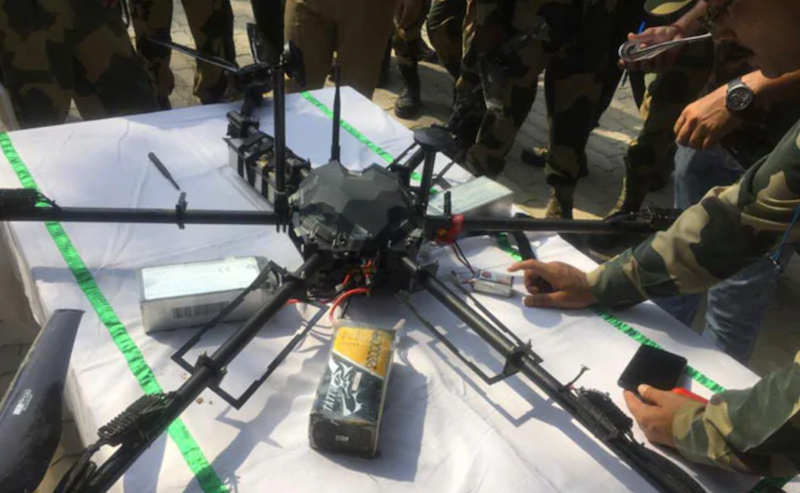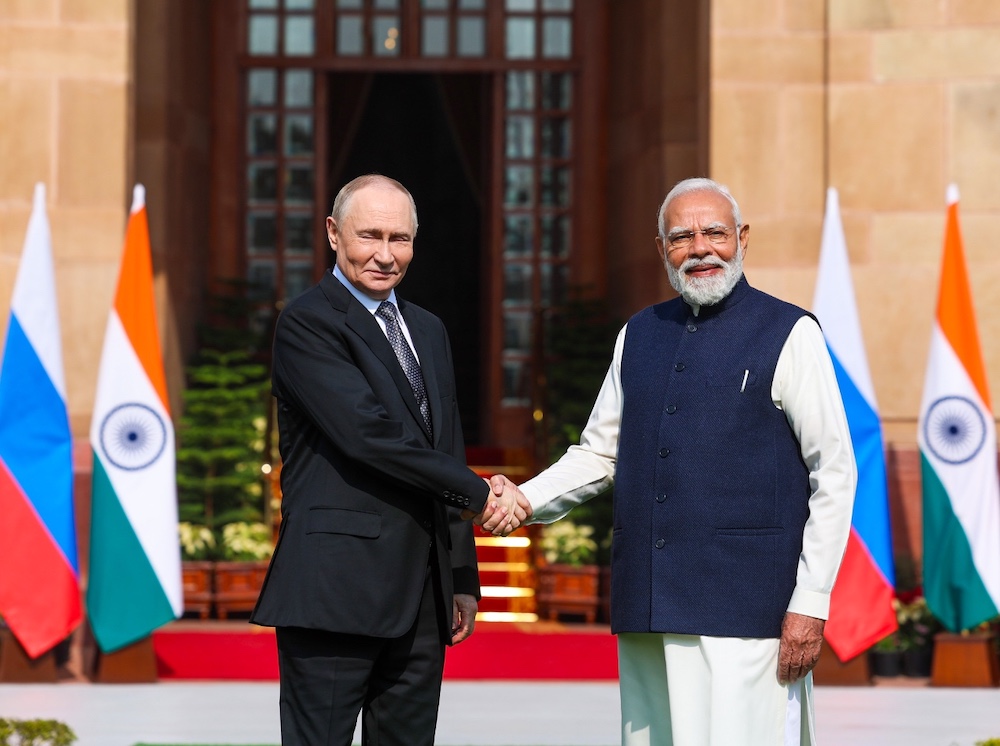 The weapons-carrying Pakistani drone that the BSF shot down in Kathua, Jammu, on June 20, 2020.
The weapons-carrying Pakistani drone that the BSF shot down in Kathua, Jammu, on June 20, 2020.
The preoccupation of the nation with the happenings in eastern Ladakh has caused the strategic community to lose sight of one significant incident development on the India-Pakistan border – the shooting down of an armed drone by Border Security Force troops, deployed at Pansar border outpost (BOP) in Kathua under the Jammu Sector, in the wee hours of June 20. The incident appears to have more or less been of no significance to the media and the strategic community in the country.
Drones have been sighted earlier also; however, it is a first that a cache of weapons has been recovered from a downed drone. The weapons were obviously meant for the terrorists operating in Kashmir. The drone, if undetected would have been guided to a rendezvous point from where these would have been retrieved and despatched to the valley.
The incident, besides unequivocally establishing the involvement of Pakistani deep state in aiding and abetting militancy in India, also goes to prove that the militants and their handlers are compelled to explore newer ways of infiltrating the border. They have been compelled to do so due to difficulties faced in crossing the formidable obstacle in shape of fence and better vigil being exercised by the BSF, especially along the riverine gaps. Induction of additional manpower in Jammu sector has also proved beneficial.
The incident must compel the BSF authorities to introspect and analyse fresh challenges that the border guards face in guarding the sensitive borders. The mindset of the border guards who continue to consider the exploitation of land borders by infiltrators to be the main threat and manpower-intensive methodology needs to be reviewed to ensure that the border guarding becomes more effective with better use of technology and intelligence.
Our approach towards border guarding has always been reactive. In fact, we did not even feel the necessity of having proper border-guarding infrastructure till mid-1960s. The BSF was raised only in the aftermath of 1965 war with Pakistan with exclusive responsibility of guarding the India-Pakistan and India-Bangladesh borders after it was found that the state armed police forces were not capable of handling even minor skirmishes.
The fence was conceived of as an obstacle after it was found that the infiltration of militants and logistic support to them from Pakistan could not be controlled merely by deployment of man power to guard the borders. The fence played a very important role in controlling militancy in Punjab after it was constructed in early 1990s by cutting of their logistics supplies. The obstacle later strengthened with flood lighting and other early warning systems has further strengthened the border-guarding mechanism.
However, the fence also created a sense of complacency amongst the border guards, thus inducing predictability and routine in the border-domination operations.
Transborder criminals have been quick to discern this and devised ways to overcome the fence obstacle. They resorted to methods like conceal and clear, in which they would conceal the consignment of contraband in the fields located across the fence at night and get it cleared through their accomplices during day. Discovery of such contraband in the tractors, bullock carts and other implements during searches at the gates brought out the necessity of guarding the area ahead of the fence both during day and night. While regular domination during day has improved, the domination during night has remained limited even till now, for fear of small patrol detachments being isolated and overpowered by the criminals and conniving counterpart security forces.
Several other methods like throwing the contraband from above the fence at night or sliding them through hollow pipes laid across the fence were adopted. Chance discovery of such contraband consignments being collected by accomplices of transborder criminals at night itself brought in a realization that domination of area on own side of the fence also needed to be ensured.
Discovery of tunnels emanating from Pakistan with opening on the home side of the fence added another dimension to border-guarding efforts. Since the discovery of the first such tunnel in 1997 in Punjab, several similar tunnels have been discovered in different parts along India-Pakistan border in Punjab and Jammu. One such tunnel was also found near the India-Bangladesh border at Malda, West Bengal. Most of the tunnels have been chance discoveries indicating less than optimum domination of the areas close to the fence.
The discovery of tunnels so close to the fence also indicates that the efforts of intelligence branch of the BSF (known as “G” branch) need to focus more on the important aspect of collecting information about transborder crimes. The focus of the “G” branch on collecting information about military capabilities of adversaries is a legacy from the nascent stages of raising of the BSF when it was important to do so because of extremely disturbed relations with Pakistan. In my view the focus now needs to shift to collecting information about transborder crimes and criminals. Information about capabilities of adversary should only be a secondary task.
The manpower intensive border guarding systems must give way to more technology based surveillance system. This will not only enhance effectiveness but also facilitate better rest and relief (lack of which is a major cause of premature voluntary retirements amongst troops) for troops. We need to move away from penny-packet deployment of troops in small detachments to a centrally located quick-reaction team-based system.
The QRTs equipped with appropriate communication and other equipment should be able to react in a desired time frame to intercept the criminals after receiving information from a control room, which exercises surveillance over a given area of responsibility. The systems can be linked to appropriate supervisory authority for real-time monitoring and guidance of operations. The junior leaders also need to be trained and encouraged to seize initiative and react to fast developing situations because they may not have the luxury of seeking orders from superior officers in such circumstances.
The surveillance equipment that the border-guarding forces acquire must be need based. Their utility must be assessed properly according to the prevailing operational situation and terrain instead of being vendor-driven. The first- and second-generation night-vision devices are not user-friendly, cumbersome to carry and have also out lived their life. The organization also needs to invest in familiarizing the troops with their usage otherwise they remain safely confined to stores or copiously kept in their covers even if taken out for duties. Some thermal imagers have been inducted, but they are not adequate in numbers.
The BOPs also need to be provided with proper facilities in their area of responsibility to ensure their effective use. Some laudable individual efforts through annual competitions to encourage innovativeness must be taken up for large-scale production to ease the burden on troops. In fact, these solutions are likely to be more effective because these have been devised by the end users taking into consideration the needs of ground. The technology involved in these innovations is also likely to be more user-friendly.
The credit of downing the drone goes entirely to the troops who were alert in those wee hours. Needless to say that it would have helped if they had advance intelligence. Therefore, the “G” branch needs to focus more on analysing evolving trends and coordinating with other intelligence agencies operating in the area.
The adversary is continuously evolving its tactics in order to outmanoeuvre the border-guarding forces. The leadership therefore has to be mentally mobile and have deep insight of the prevailing security environment along the borders to face up to these challenges. They must be proactive and upgrade the border-domination systems to an intelligent domination methodology, which besides ensuring adequate rest and relief to troops, also involves extensive use of intelligence inputs.
[Disclaimer: Views expressed by the author are his own and don’t necessarily reflect the views of India Sentinels.]










